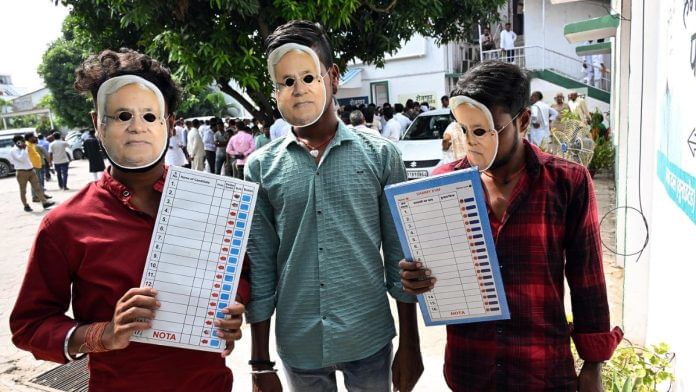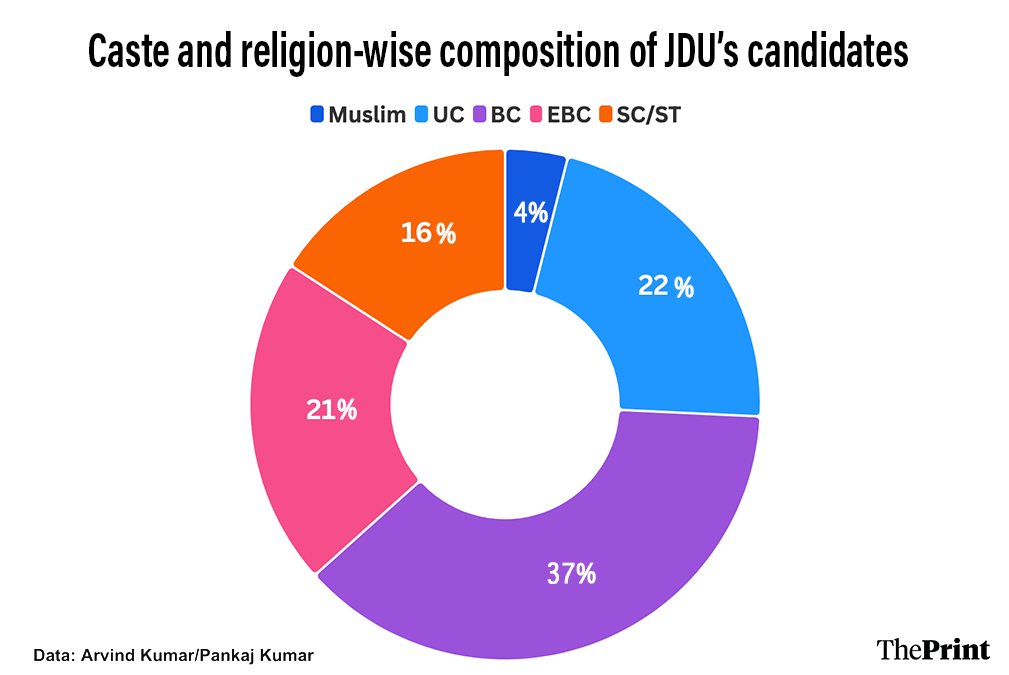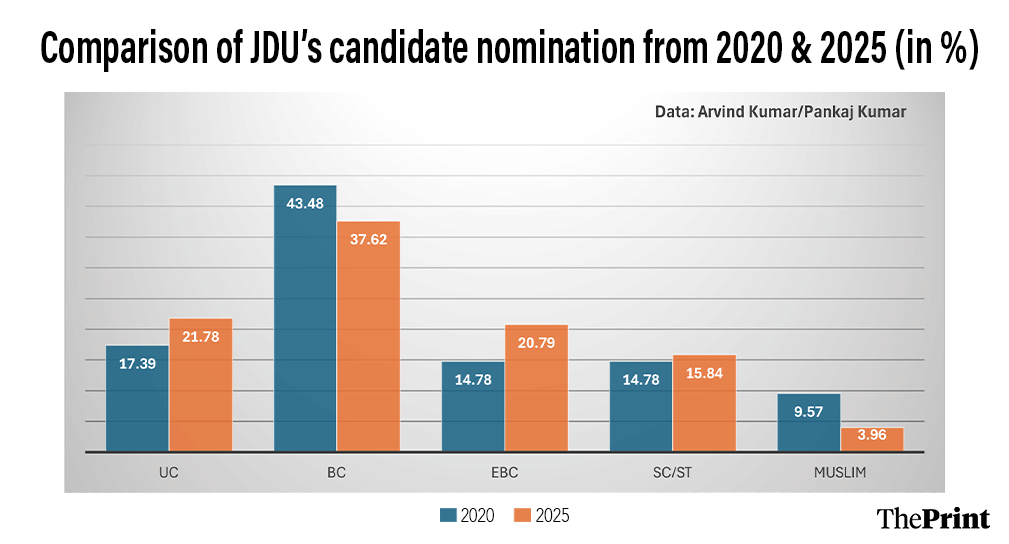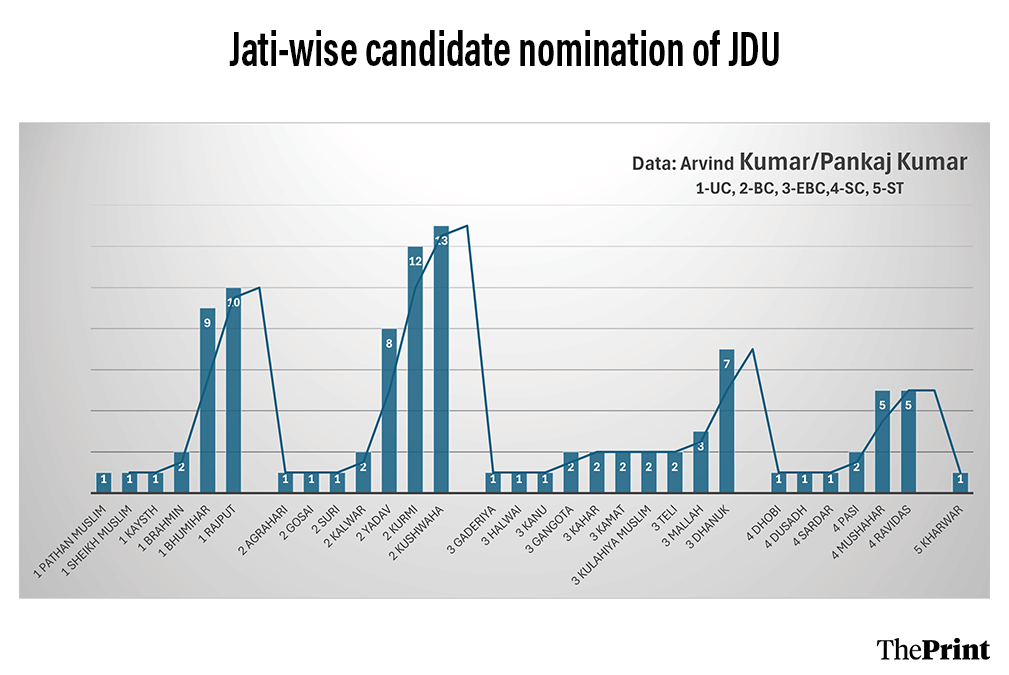Caste continues to play a significant role in the political mobilisation of Bihar. Political parties often factor caste identities when selecting their candidates. This is evident in the case of Chirag Paswan’s Lok Janshakti Party and Upendra Kushwaha’s Rashtriya Lok Morcha, both part of the National Democratic Alliance, which have publicly declared the caste composition of their candidates. While both parties are being criticised on social media, their actions highlight how deeply caste considerations are entrenched in Bihar’s electoral calculations.
This article analyses the caste background of candidates fielded by the Janata Dal United (JDU). We have compiled the data through interviews with local leaders across Bihar. We find that the JDU’s focus has shifted from Backward Classes (BCs) and Muslims to Extremely Backward Classes (EBCs) and upper castes. Within the Backward Classes, Yadav representation has declined from 18 to eight nominations.
Caste composition of JDU candidates
Under the NDA’s seat-sharing arrangement, the JDU has been allocated 101 seats. It is equal to the BJP’s share, but lower than its 2020 quota, when it contested 115 seats. The party has declared candidates for all 101 constituencies.
Figure 1 shows the caste-wise distribution of tickets across five social groups—Backward Classes (38 seats), upper castes (22), Extreme Backward Classes (21), Scheduled Castes/Scheduled Tribes (16), and Muslims (4). In this classification, Muslims include both Pasmanda and upper-caste Muslim groups.
As per the Bihar caste survey, Backward Classes (BCs) constitute 27.13 per cent of the state’s population, while EBCs account for 36 per cent. However, this demographic weight is not proportionally reflected in the JDU’s candidate nominations. Similarly, Muslims make up 17.7 per cent of Bihar’s population, but they represent only four per cent of the party’s nominated candidates.
When we compare JDU’s caste- and religion-wise candidate nomination strategy for the 2025 election with that of 2020, we find that the proportion of candidates from upper castes and EBCs has increased (Figure 2).
Despite decline in the total seats of the JDU in NDA, the party has increased the nomination of upper castes from 17.39 per cent to 21.78 per cent and EBCs from 14.78 per cent to 20.79 per cent. There has been a nominal increase in the nomination of SC/ST candidates, with none from the two groups nominated in the general constituency. The nomination of BCs has declined from 43.48 per cent to 37.62 per cent, and that of Muslims from 9.57 per cent to 3.96 per cent. The party’s all 11 Muslim candidates in 2020 lost the election, which could be the reason behind nominating fewer Muslim candidates this time.
Also read: TV news isn’t telling which way Bihar Assembly election will go — only who is unhappy
Jati-wise candidate composition
Caste does not always operate at the broader category level, but often at the level of individual jatis. Therefore, we also examined the jati-wise distribution of JDU’s candidate nomination.
Figure 3 reveals that within each caste category, the distribution of candidates is skewed in the favour of certain castes. For instance, within upper castes, it is skewed towards Rajputs (10) and Bhumihars (9). The party has nominated only two Brahmins and one Kayastha. Its other two upper caste candidates are Muslims — Sheikh and Pathan.
Among BCs, the distribution is skewed towards Kushwaha (13), Kurmi (12), and Yadav (8). The JDU was once called the party of Lav-Kush, where Lav meant Kurmi and Kush meant Kushwaha, which is still reflected in its jati-wise candidate nomination. The representation of Yadavs has substantially declined. In 2020, the party nominated 18 Yadav candidates, but only seven won. This time, the party has given tickets to only eight Yadav candidates.
EBCs are considered to have become a strong support base of the JDU. From this social group, the party has nominated the highest number of candidates — Dhanuk (7), Mallah (3), Teli (2), Kulahiya Muslim (2), Kamat (2), Gangota (2), and one each from Kanu, Halwai, and Gaderiya. It would be interesting to see if EBCs remain loyal to the JDU because the Rashtriya Janata Dal (RJD) is also aggressively wooing the group.
Furthermore, the JDU has nominated a total of 16 candidates from the SC/ST communities. In the last election, it nominated 17 such candidates. Within SCs/STs, its nomination is skewed towards Ravidas (5) and Mushahar (5), with only one candidate from the Scheduled Tribes. There are 23 castes listed in the list of Scheduled Castes of Bihar. But there are only seven SC communities represented in JDU’s nominations.
Arvind Kumar is a Visiting Lecturer at the University of Hertfordshire, and Associate Fellow at the Institute of Commonwealth Studies, University of London. Pankaj Kumar is a PhD Scholar at Jamia Millia Islamia. Views are personal.
(Edited by Theres Sudeep)










This is not correct way of analysis. Better you do for whole of NDA as they all four also aligned on which cast will represent how many seat. JDU may have give. Less seats to OBC but they are compensated by other NDA group parties by giving more seats to OBC. Not giving seats to Muslim is right approach as they now they don’t vote for JDU.
Why don’t you do it for even BJP and RJD and Congress with a table of comparison and then we will know which party is the most casteist defying the population ratio in the state.